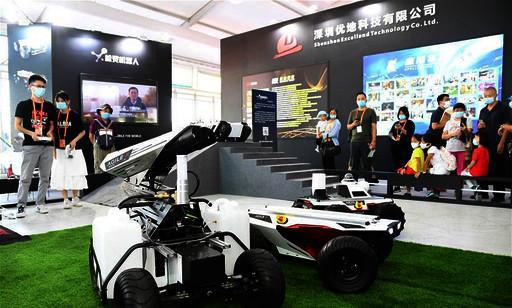
. > WHAT'S NEW > TOPLINE
Service industry embraces wave of openness and innovation
Author : ZHANG YI Source : Chinese Social Sciences Today 2020-09-25

A disinfection robot adaptive to indoor and outdoor environments shown at the China International Fair for Trade in Services Photo: Ren Chao/XINHUA
The 2020 China International Fair for Trade in Services (CIFTIS) wrapped up on Sept. 9. At the fair, China announced a series of important measures supporting the development and opening up of trade in services.
From the “Made in China” of the Canton Fair and the “Chinese market” of China’s International Import Expo to the “Chinese Services” of the CIFTIS, China has unswervingly expanded its openness to the outside world and promoted the inclusive growth of the world economy. This wave of opening up surges forward, and will accelerate the establishment of a “dual circulation” development pattern in which domestic economic cycles play a leading role while international economic cycles remain an extension and supplement.
At the Forum on the Emerging Trends in the Opening up and Development of Trade in Services on Sept. 5, Jiang Xiaojuan, dean of the School of Public Policy and Management at Tsinghua University, mentioned the intelligent medical quarantine cabin which was designed in just 48 hours and put into use in half a month during the height of the COVID-19 outbreak in Wuhan. It demonstrates the benefit of an industrialized digital platform and shows China’s speed at responding to the epidemic. Jiang used this example to illustrate new development and opportunities provided by the rapidly changing digital service industry.
“The service economy has become a new driving force for economic growth,” said Wang Bingnan, vice minister of commerce. At present, the service industry has created 70% of the global economy, 45% of jobs, 60% of global direct investment and over 50% of crossborder mergers and acquisitions. With the adoption of the digital economy, trade patterns, business models and transaction methods of services are all undergoing profound changes. The productive service industry represented by R&D, finance, logistics, distribution, and information and communication technology, has already become a key link in the value chain. The service economy, supported by new infrastructure and represented by online services, is activating development momentum in various fields and becoming the most dynamic part of economic growth in China.
Long Guoqiang, deputy director of the Development Research Center of the State Council, pointed out that the increasingly prominent trend of servitization in the manufacturing industry is speeding up the convergence of manufacturing and services. The productive service industry is developing rapidly. The division of labor in traditional industries and the boundaries of industrial layouts are broken. The support of services for industrial development—especially for the digital, network, and smart transformation of the manufacturing industry—is more obvious.
“The opening up of the service industry is our focus in the new round of open development. Open cooperation will be beneficial to enhancing the competitiveness of the service industry in international trade and will facilitate the integration of all countries, especially of developing countries, small and medium-sized economies and small and medium-sized service providers, into the global value chain,” Long noted.
The rules of global service trade have been restructured, Long continued. As a new fulcrum for economic development and international cooperation and competition, the trade in services is increasingly more open, and has become the focus of the new round of international economic and trade rules reconstruction.
Chinese services will become a giant magnet. On Aug. 13, the People’s Government of Hainan Province signed strategic cooperation agreements with the Bielefeld University of Applied Sciences of Germany, aiming to independently run foreign colleges in the Yangpu Economic Development Zone of the Hainan Free Trade Port. Enrollment is planned to start in 2021.
Many multinationals have decided to continue to be based in China, and several significant foreign investment projects have sped up their implementation. This demonstrates their firm confidence in China’s peaceful and open development. In the first seven months of this year, China’s foreign capital in actual use was RMB535.65 billion, a year-on-year increase of 0.5%, of which the service industry actually absorbed foreign capital of RMB414.59 billion, with a year-onyear increase of 11.6%.
A work plan to expand the opening up of the service industry in Beijing approved recently by the State Council put forward the overall requirements for developing a national integrated demonstration zone for greater openness in the services sector and clarified phased goals in 2025 and 2030. The plan focuses on nine key industry sectors, including science and technology services, digital economy and trade, financial services, commerce, culture and tourism, education services, and health care. It also proposes 26 new measures for opening up and innovation, which will intensify efforts to pioneer in coordinated policy, high-tech industry cultivation, innovation and entrepreneurship, and support services for high-end talent. This article is translated and edited from Guangming Daily.
Ye Shengtao made Chinese fairy tales from a wilderness
Ye Shengtao (1894–1988) created the first collection of fairy tales in the history of Chinese children’s literature...
-
How northern ethnicities integrated into Chinese nation
2023-09-18
-
Mogao caves
2023-09-12
-
Mogao Grottoes as ‘a place of pilgrimage’
2023-09-12
-
Time-honored architectural traditions in China
2023-08-29
-
Disentangling the civilizational evolution of China
2023-08-28
-
AI ethics in science fiction
2023-08-23













 2011-2013 by www.cssn.cn. All Rights Reserved
2011-2013 by www.cssn.cn. All Rights Reserved